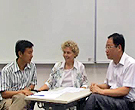SBA in the 2012 HKDSE English Examination
Assessment Criteria
SBA in the HKDSE uses the same assessment criteria that were developed for the HKCEE for both Parts A and B. Maintaining the same assessment criteria was felt to be essential as teachers are already familiar with these domains for assessing oral language development and therefore more confident making judgements according to the levels on the existing criteria. The criteria are now applied to a wider range of students (from S4-6) and a wider range of topics and themes from the electives. As they are based on students’ underlying oral English language proficiency in individual presentations and group interaction, the criteria are still able to capture the full range of abilities from little or no use of English to highly competent use.
 |
|
Note: At S4 assessment should be used primarily for formative purposes, that is, to identify students' strengths and areas that could be improved; and the implications of this for the teachers' planning and teaching programmes. However, such assessments may also be used for more formal summative assessment and reported on students' progress within the school. |
In the HKDSE, as in the HKCEE, there are four domains to assess oral language development:
The domains are the same for both task types—individual presentation and group interaction—and for both Part A (The reading / viewing programme) and Part B (the Elective Programme) but some elements are described differently in the two task types because the kinds of spoken language that are needed in different situations are somewhat different.
Each of the domains has a set of descriptors at each of six levels. This set of levels and descriptors make up the assessment criteria. ![]() Click here to view the assessment criteria.
Click here to view the assessment criteria.
 |
|
| Note: Remember that the ability of a student is measured by the quality and range of the oral language produced for assessment, including both fluency and accuracy, not by the speed of completion, or total number of words. |
The assessment criteria provide teachers with a common language to describe students' oral language use in ways which are comprehensive, specific and yet constructive.
